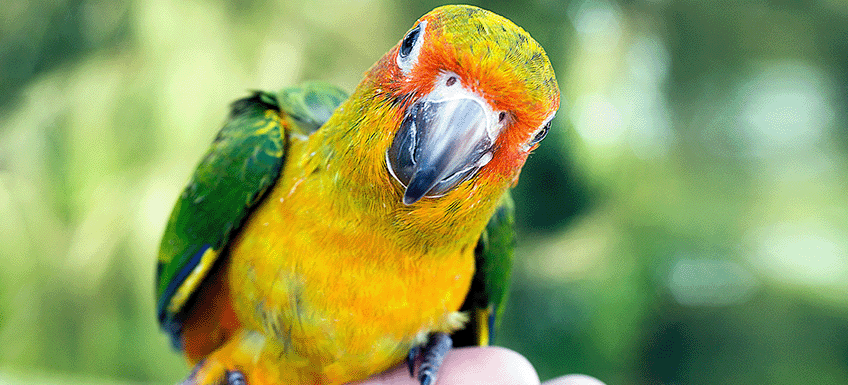
How to Understand Common Bird Behaviours
Bird
Training and Behaviour
15/05/2023
Although many things that your bird does is pretty self-explanatory – such as eating, flying, bathing, and climbing. There are other types actions or behaviours that can be a little harder to understand the meaning of. It is common for first time bird owners to misjudge their bird’s behaviour and wonder why they received a bite or why the bird fluttered off their hand. So it is always good to understand what common bird body language means, as this makes it easier for to read and understand what your bird is trying to tell you!
Eye pinning
A common behaviour in parrots with light-coloured eyes is eye pinning. This is when the pupil dilating in and out. It commonly happens when a bird becomes excited, and is a commonly seen behaviour in amazon parrots, macaws, ring necks and African greys, but can happen in any parrot.
Beak grinding
Birds often grind their beaks especially when they are falling asleep at bedtime. This is a common sign that your bird is happy and relaxed, and it a behaviour that helps to keep their beaks trimmed.
Feather fluffing
A bird will ruffle and fluff up its feathers after preening to help to remove any debris. They also fluff their feathers when it is cold in order to keep warm. But if you notice your bird has his feathers continually fluffed, this could be a warning sign that your bird is ill or its environment is too cold and it is trying to keep warm.
Beak wiping
Birds will often wipe their beaks on perches or the cage bars after eating to remove debris, such as food from their beaks.
Crest position
If you have a bird with a crest like a cockatiel or cockatoos you can tell a lot about their mood from their crest feathers. Straight-up crest feathers can mean the bird is startled or highly curious. A defensive bird will hold its crest feathers flattened down close to its head. A relaxed bird will have slightly held back crest feathers, as well as fluffed cheek feathers and you might also hear it contentedly grinding its beak.
Flapping wings
Birds often hold on tight to the perch and flap their wings madly as if wanting to take off in flight. This is completely normal behaviour, especially in birds who cannot fly due to having their wings clipped. This is a birds form of exercise and is something they do when they are happy, it can also be part of breeding behaviour.
Chattering
Small birds chatter throughout the day for various reasons. Most birds are the most vocal at dawn and dusk, when they’re getting ready to feed. Some small birds will even chatter in their sleep during the day, a protective adaptation to show predators that they are awake and alert, not napping and vulnerable.
Flock calling
You may notice that your bird seems to “call” you persistently and won’t quiet down until you enter the room. In the wild, this is called “flock calling.” It is completely natural as birds like to know where their partners are, so they call loudly expecting that the other will call back. This helps partners locate each other and affirms that both are safe. Your bird may want to participate in “contact calling” with you. It’s really easy — if you sense that your bird is calling you, either by screaming or whistling, simply call back that you’re okay. You can make a game of it. This helps the bird feel secure and will usually quiet him down after a few calls.
Hissing
Cockatiels and African greys are a couple of bird species that are well known for hissing when they feel threatened. If a bird hisses or growls at you, back off, this means that the bird feels cornered and may bite or lash out to protect himself.
Feather picking
It is natural for birds to spend most of their time grooming their feathers, and it is not uncommon to find dropped feathers on the bottom of a cage. But if a bird suddenly starts pulling or plucking feathers, this is an abnormal behaviour, which is very complex and can have many causes, both medical and psychological. If you notice your bird is plucking feathers it is important that you visit a bird savvy vet to determine the cause of the behaviour.
Regurgitation
Regurgitation is the act of bringing up undigested food from the crop and regurgitating it. This is a relatively common behaviour in parakeets, cockatiels and some larger birds. As strange it seems, your pet is strongly bonded to you and when it regurgitates food for you it is trying to “share its feed.” Birds may also do this to their cage mates or breeding mates, as it is a way of showing affection. Although this behaviour is a lot more common during the breeding season.
Sleeping on one leg
A raised leg with a ‘clenched’ claw is simply a way or resting. In the cold birds often stand on one leg to preserve warmth. But it is totally normal for birds of all species to sleep or rest on one leg.
Tail bobbing
A tail that bobs gently up and down and accompanied by panting means the parrot is catching his breath after strenuous exercise. Although if tail bobbing happens when no exercise has taken place, it can be a sign of illness or shortness of breath so it is important that you contact the vet.
Knowing what these behaviors mean can help you better communicate with your bird and ensure their well-being